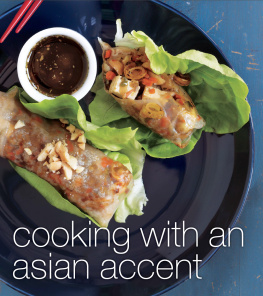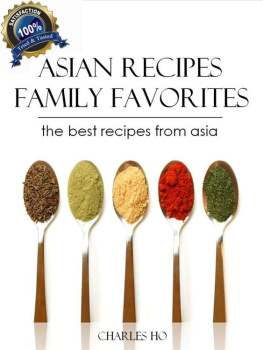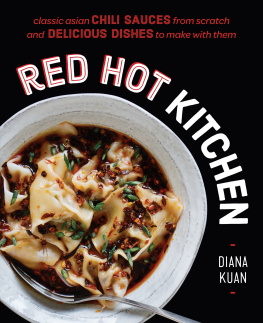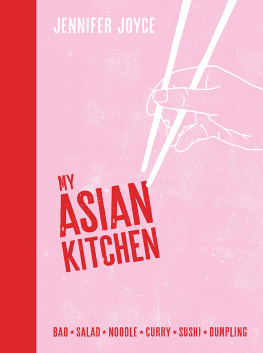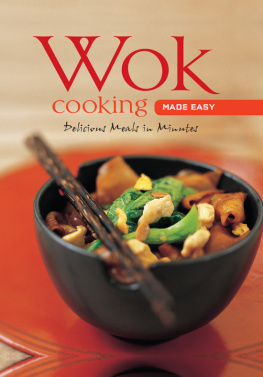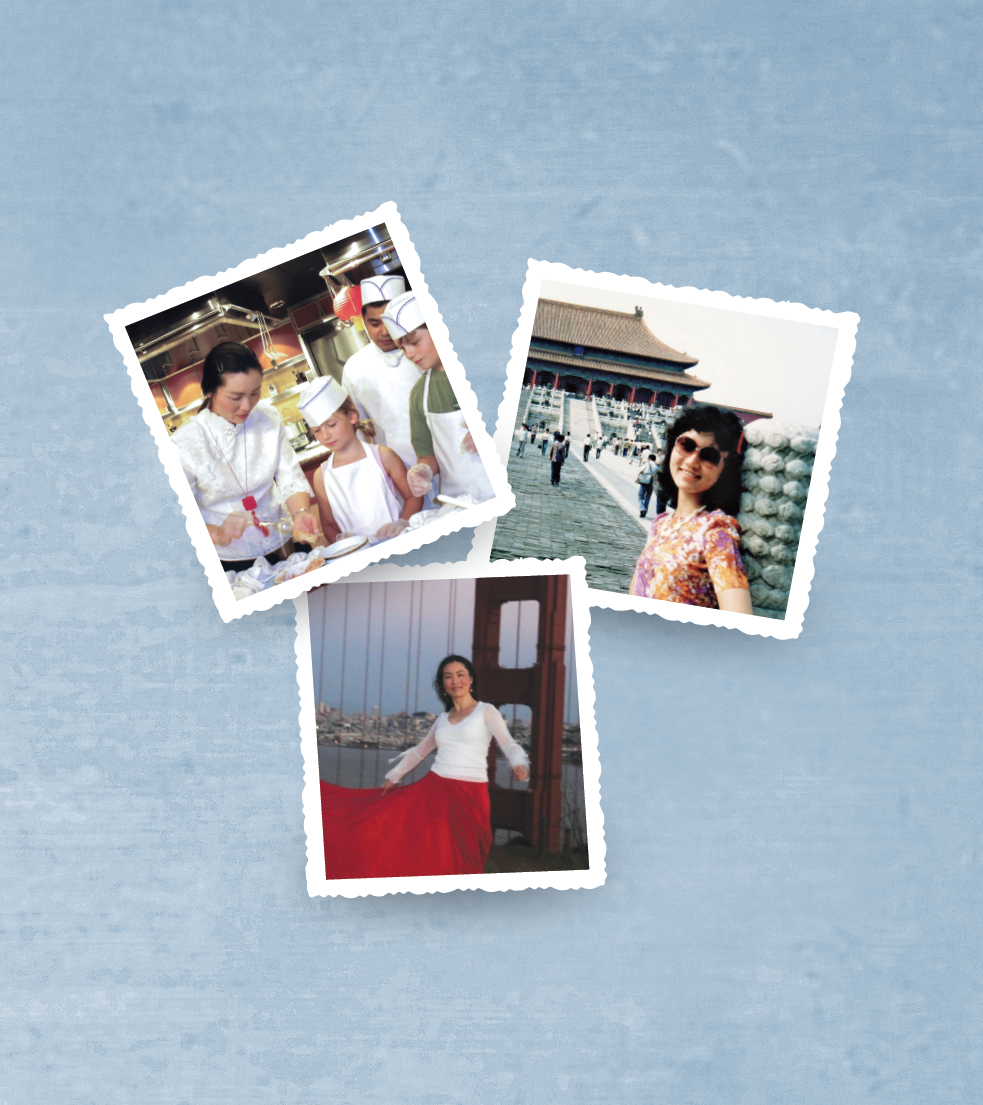Copyright 2014 by Ying Chang Compestine. All rights reserved.
Published by Houghton Mifflin Harcourt Publishing Company, New York, New York.
Published simultaneously in Canada.
For information about permission to reproduce selections from this book, write to Permissions, Houghton Mifflin Harcourt Publishing Company, 215 Park Avenue South, New York, New York 10003.
Compestine, Ying Chang.
Cooking with an Asian accent : Eastern wisdom in a Western kitchen / Ying Chang Compestine.
p. cm.
Includes index.
1. Cooking, Asian. 2. Cookbooks. lcgft I. Title.
acknowledgments
Like my journey from Wuhan to California, this book has traveled a long way. I received much inspiration and support from my family, friends, editors, and readers.
A special thanks to my publisher, Natalie Chapman, for your support and flexibility that enabled me to elevate the book to the highest level. Thanks to Brittany Edwards for your enthusiasm and dedication to the books success.
I am indebted to Edn Bunchuck and Jacqueline Beach, for your patience and invaluable help. Thanks to Jillian Saland and Christine McKnight for championing this project and your assistance. It has been a great pleasure working with everyone at Houghton Mifflin Harcourt!
Thanks to Dani Fisher for bringing my recipes to life, and to Mariana Velasquez for your exquisite photographs. Thanks to Alison Lew for your tireless effort to create a stunning design for the book.
Thanks to my intern Nicole Price for your help and hard work during one of the most frantic and exciting times in my career, making it possible for me to juggle many balls at once.
Throughout my writing career, I have always been looking for new ways to save time and make cooking more enjoyable. Im fortunate to have received assistance and support from the following companies, whose products Ive found to be superior: Jenn-Air (luxury kitchen appliances), Calphalon (nonstick and stainless steel cookware), Cuisinart (countertop steam ovens), Vitamix (blenders), Zojirushi American Corporation (rice cookers), and J.A. Henckels International (knives).
Thanks to Beth Hensperger, Margaret Lee, Jill Melton, Regan McMahon and Blair Jackson, Lee and Anne Geiger, Mark and Carol Escajeda, Zora Wan and Kevin Hummel, Zali Lorincz, Chris Krueger, Rich Van Druten, Yshel Lok, and Gerri and Jack Joyce; your friendship enriches my life!
Last but not least, I would like to thank my son, Vinson, my most efficient and intuitive assistant, for chopping, mincing, and marinating. Thanks to my husband, Greg, for your continued support and tireless cooking, cleaning, and tasting.
introduction
On a snowy night in 1984, I stood outside one of the finest restaurants in Beijing. Locals trudged by, oblivious to my presence. As they battled through the northern wind, the corners of their cotton coats flapped like birds wings. I pulled a red woolen scarf over my head, anxious to carry out my first assignment.
I had recently graduated from Huazhong Normal University in Wuhan, the city of my birth, with a degree in English and American literature. My job as an interpreter for Chinas National Seismology Bureau required me to travel throughout China to host banquets and conferences, where I would translate for Chinese delegations of government officials, scientists, and foreign geologists.
When the six American geologists finally arrived in a van, escorted by the secret police, I struggled to remove the mittens from my icy-cold hands to greet them. Once inside the heavily carpeted banquet hall, I was embraced by soothing classical Chinese music. Beautifully dressed waitresses immediately brought us jasmine tea. As they filled our cups, the hot tea perfumed the air with a light chrysanthemum fragrance. I held the cup with both hands to warm my stiff fingers. Soon, my appetite was aroused by the aromas of pristinely fresh fish, crisp vegetables, steaming jasmine rice, and simmering spicy noodles heaped on the lazy Susan in the center of our banquet table.
As hungry geologists and chubby government officials enjoyed the meal, I had to stay alert, translating between Chinese and English while fulfilling the duties of a gracious dinner host. At that time, I was not as proficient in English as I am now, and I struggled to translate many of the complex technical phrases, such as levels of damage from the earthquake in Tangshan and data from the satellite stations. Before long, I was glowing with perspiration in my formal wool dress. I felt relief when more dishes arrived and conversation finally slowedEmperors Shrimp, savory meatballs, delicate vegetables, flavored rice in bean paste, bean pancakes. Throughout the parade of courses, attentive waitresses continually replenished our small, elegant porcelain bowls with fresh rice or noodles.
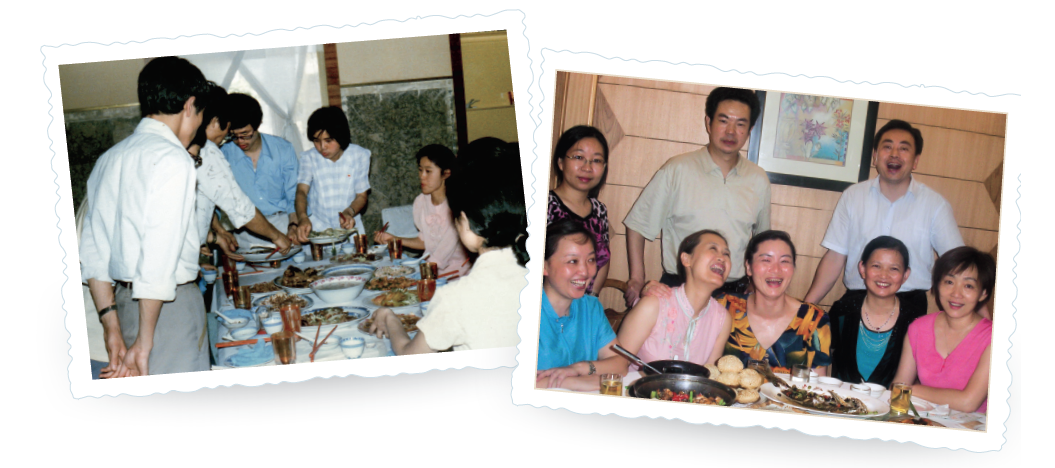
In Chinese, the six officials and I expressed bemusement at our foreign guests style of dining. As soon as the waitress set down a new dish, one of our guests would eagerly pick it up, scoop a portion onto his plate with his fork, and pass it on to the next person.
The director of the Seismology Bureau sitting beside me asked, Dont they know that they arent supposed to lift the dishes off the table?
Thinking of the long government meals I had sat through, I smiled and answered, It is more efficient than taking small portions with chopsticks.
I was proud of my response, but had no answer to the officials incredulous remarks when the geologists requested glasses of ice water and cold Tsingtao beer. Cold drinks on a cold day? Why arent they drinking their warm tea? Dont they know about yin-yang balance?
Even after experiences like this, it was not until I came to the United States that I fully realized how differently our two cultures view food. Asians often see Westerners as unschooled in the concepts of yin-yang balance and food as medicine. They also stereotype Western-style meals as consisting of flavorless vegetables and slabs of meat accompanied by unhealthy cold drinks.
Asian and Western cooking styles differ in that the Western cook expects the diner to do all the work of cutting up ingredients at the table, such as an uncut steak accompanied by a whole baked potato, while the Asian cook does all this in the kitchen. Because of this extra preparation, and what may be unfamiliar ingredients, spices, and cooking equipment, Westerners often shy away from preparing Asian meals at home. Yet modern Westerners are adventurous eaters, eager to try new tastes and flavors.

